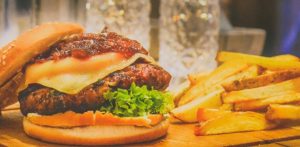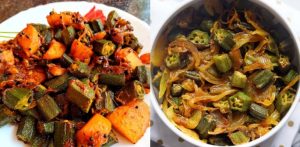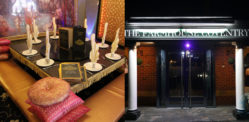They were fascinated by the food on offer
Indian restaurants are a staple in the UK, from curry takeaways to immersive sit-in slices of India.
However, they aren’t a modern establishment or something which became a trend.
In fact, Indian restaurants have been around in England since the 18th century.
With food heavily adapted to the British palate, Indian restaurants – and their curries – are products of the UK rather than being authentically South Asian.
Here we take a look at the beginnings of the Indian restaurant, and how it has become so embedded in British culture.
Beginnings
The beginning of Indian restaurants in England goes as far back as the 18th century.
During this period, East India Company men who traded in South Asia brought recipes for curry and other Indian staples back to England.
These men were known as ‘nabobs’, which is English slang for nawab, and worked as deputy rulers.
They were fascinated by the food on offer and wanted to bring Indian cuisine home with them.
British cuisine was a far more bland and simplistic palate, and India’s food and charm had Brits hooked.
The richer ‘nabobs’ brought Indian cooks back to England with them to prepare their meals, but there were also coffee houses set up across the UK which introduced a wide range of people, from lower classes to the wealthy, to the unusual and delicious dishes.
However, from the start, South Asian dishes were heavily altered to suit the tastes of British people.
The word ‘curry’ itself is a European creation during the colonising years.
‘Indian’ Restaurants
Despite a great deal of genuine Indian restaurants appearing in the UK, other South Asian countries struggled to get their authentic voices heard.
Bangladeshi entrepreneurs had their beginnings as the lascars (sailors) that worked on European ships from the 16th to the mid-20th century.
Some of them would prepare food onboard and eventually came to London during the 1700s.
Much like the Indian chefs who came to England, these lascars set up shop in ports to cook for other sailors.
However, they soon advertised themselves as ‘Indian’ restaurants to tempt more customers.
India was a well-known, bigger country, and it was easier to get British diners through selling ‘Indian’ food.
As well as Bangladeshi chefs selling ‘Indian’ food, Pakistani restaurants also sold food under a different country title.
Pakistan had a great influence on British South Asian food culture, particularly the Balti and Karahi dishes.
Balti, named after the large dish which food is both cooked and served in, was a largely created for the British consumer.
The most popular Balti in Britain is the Birmingham Balti, which was crafted in that area and developed with influences from Pakistani and British culture.
The steel bowl-like dish which resembles a ‘small bucket’ known as the ‘balti’ was created in the region for this dish.
Tara Singh, the Punjabi owner of a company called Pressform in Birmingham, helped design the signature utensil with Mohammed Arif the owner of Adil’s.
It was a dish similar to the karahi but made of thin, stainless steel.
In fact, Balti dishes served in the UK don’t resemble traditional Balti gosht, instead of remaining a hybridised creation for British customers.
Hindoostane
The first purely Indian restaurant was the Hindoostane Coffee House, which went into business in 1810.
It was also the first restaurant that served Indian food that was actually owned and ran by an Indian person.
This person was Sake Dean Mahomed, one of the most notable Indian entrepreneurs and non-European immigrants who came to England.
He served as a captain in the British East India Company Army before moving to Cork in Ireland with his mentor, Captain Godfrey Evan Baker.
There he learned English and married an Irishwoman before moving to London.
As well as his restaurant, he was also the first from India to write a book in English, and also introduced the shampoo baths to England.
The Hindoostane Dinner and Hooka Smoking Club, which later became the Coffee House, served British food with an Indian twist, keeping with the tradition of Indian food becoming Anglicised.
Mahomed also offered an authentic Indian experience to his patrons, including a room to smoke shisha.
He sold the business a year later due to lack of business, though it remained open until 1833. The venture may have fallen through, but Mahomed had kicked off a whole new dining experience in England.
This experience includes the modern-day home delivery service, which Hindoostane offered and inspired other restaurants to do.
Popularity
India and its cuisine’s popularity wavered. In 1857, India rebelled against the British rulers, and thus damaged the charm of India in Britain. Indian cuisine and culture was no longer the fashion.
However, despite its fall due to political reasons, the food remained a staple meal that was firmly kept in British culture.
It was continuously consumed, becoming a popular meal at lunchtime, and the demand for it never disappeared.
Britain returned to favouring India when Queen Victoria came to rule, as her fascination for the country and its dishes sparked the fancy of many royalists.
As for the food itself, curry wasn’t a popular meal in the early 20th century.
One complaint that kept it from being one of the top dishes was the strong smell, which was considered off-putting.
But Indian restaurants were about to boom with a bang.
Indian sailors arrived at Britain’s ports, fresh from the Bangladeshi region of Sylhet. These men had either jumped from their ships or had been sent to places such as London.
Needing a job, they started their Indian-focused cafes.
These cafes, much like the ones of previous years, catered for the Asian community which was growing in England.
As there were plenty of bombed cafes and restaurants still lingering since the war, caterers took advantage by setting up shop there.
Knowledgeable of the country and its customers, they welcomed the trade of the British too, selling typical British dishes such as fish and chips as well as the classic curry.
Immigration
There are several reasons why Indian restaurants became so popular in the mid-20th century. Immigration was a leading reason because since the 50s, there was an increase in the South Asian community.
With more homesick people to cater for, there was a higher demand for Indian restaurants.
Likewise, there was a surge in the South Asian population in Britain in the 1970s. People from Bangladesh came to England due to war in their home country.
The population that came brought with them their own produce and ingredients, which helped Indian food to take off as more restaurants were supplied. Many of the immigrants would work in catering.
Britain itself was stuck in wartime rationing until 1954, meaning a lot of food and ingredients weren’t available.
Once food became available it was easier to get spices for Indian meals.
Newcomers to the country would flock to the dishevelled East End; soon there were plenty of restaurants blossoming in that area, as well as the rest of London and the South East.
In the 1970s, some of the more popular diners at Indian restaurants were the white working-class, who tended to enjoy the reasonably-priced meals – particularly as the menus were often adapted for them as a group.
Indian takeaways also took off from their clever scheme of remaining open until late, a move which started in the 1940s, so that people who were leaving pubs could stop by for a meal.
This Indian food and pub culture is another aspect of early Indian restaurant business which has remained firmly embedded in British life.
Overall, the number of restaurants in Britain was six in 1950, but by 1970 there were 2,000 Indian restaurants across the country.
In 2011, it was reported that there was approximately 12,000 and the number continues to climb drastically since.
Veeraswamy
One of the most memorable Indian restaurants in the UK is also the oldest surviving. Veeraswamy, which began business in 1926, was founded by Edward Palmer.
Palmer retired from India’s Armed Forces and wanted to train to be a doctor, but the restaurant became a distraction that still serves food today.
The aim of Veeraswamy was to honour his parents, and as the great-grandson of an English General and an Indian princess, he maintained his colourful heritage with his ties in both Britain and India.
Palmer named the restaurant after his grandmother, who also shared a passion for Indian food and was part of his inspiration for an interest in the cuisine.
The restaurant was soon brought by Sir William Steward in 1934, and it became the place to be if you were famous.
Some of the clientele included Sir Winston Churchill and Jawaharlal Nehru, as well as plenty of others in its hall of fame.
In fact, it is so beloved by the rich that even Queen Elizabeth II requested the restaurant for a function at Buckingham Palace – the first time Her Majesty requested outside catering.
The Shish Mahal
Another memorable and long-standing Indian restaurant is the Shish Mahal, which is also known as the home of chicken tikka masala.
Still surviving, the Shish Mahal kicked off in 1964, when Indian restaurants were beginning to become an important part of British – and Brit-Asian – culture.
The founder, Ahmed Aslam (also known as Mr Ali) provided meals for those that were seeking true authentic Indian food, compared to the tinned basics on offer at local supermarkets.
The Shish Mahal is an example of Asian food remade to suit the British palate.
When serving chicken tikka, a dish which goes back to the 16th century, it was dismissed by a customer as being too dry.
To adhere to the British appetite, it was mixed with Campbell’s Condensed Tomato Soup, and thus the chicken tikka masala was born – and remains one of the most popular dishes in British Indian restaurants and takeaways.
The Balti Triangle
A famous Indian restaurant hotspot in the UK is Birmingham’s Balti Triangle, situated along Ladypool Road, Stratford Road and Stoney Lane to the South of Birmingham’s city centre.
In the 70s, Birmingham Balti was served, originating in 1977 in the Indian restaurant, Adil’s.
By the 1990s, the dish became extremely popular.
The Balti Triangle blossomed during this period, and the City Council gave the Triangle of Indian restaurants its name in order to market the area as a tourist attraction.
At its peak, there were 46 restaurants situated in the Balti Triangle.
Some of the incredible restaurants that remain today include Shababs Balti Restaurant, which was founded in 1987 and has had celebrity visits.
It is considered one of the four authentic Balti restaurants that remain.
Other brilliant restaurants that specialise in Balti are Al Frash, which has been known for its coconut notes in meals, and Balti pioneer since 1977, Adil’s.
The Triangle has expanded since to accommodate jewellery shops, bridal stores and restaurants from other nationalities.
The Curry Mile
Another place populated by Indian restaurants is Manchester’s Curry Mile. The Mile goes back as far as the 1980s, situated on Wilmslow Road in Rusholme.
With an even earlier history than the Balti Triangle, the Curry Mile first began with cafes in the 50s and 60s, where Asian textile workers would meet and have food.
As more Asian people moved to the area through the 70s, Rusholme’s community was soon populated by South Asian families and restaurants.
By the 1980s, Wilmslow Road caught the name ‘The Curry Mile’, which still sticks today.
The Indian restaurant which has survived the longest on the Curry Mile is Sanam Sweethouse & Restaurant, which has been part of the area since 1963.
It is known for its longevity, Pakistani and Indian cuisine as well as its famous confectionary, Mithai.
Other restaurants include café Al Madina and modern MyLahore – the latter being an example of how the Curry Mile has adapted to change with the times.
The Growing Industry
Indian restaurants have only grown in number across the UK, with more than 12,000 curry houses doing business across the country, compared to 1,200 in 1970.
Even 50 years after the Indian restaurant business began, they are still ever popular and continue to expand and grow.
With the emergence of technology, the internet and delivery apps, accessibility has increased along with the number of Indian restaurants, resulting in more customers and more business growth.
As well as websites and social media to advertise Indian restaurants and keep within the public eye of customers, Indian restaurants remain a firm part of British culture.
Similarly, the commercialisation and expansion of many Indian restaurants mean the industry sees more of these businesses across the country, as locations expand and individual restaurants grow.
An example of this is the highly popular South Asian street food company, Bundobust.
After collaborating businesses joined forces, there were soon multiple restaurants across the country, including Manchester and Liverpool.
Likewise, the famous and booming Asha’s, owned by Indian playback singer Asha Bhosle, has elevated to not only multiple UK restaurants (such as Birmingham and Solihull) but also South Asia itself.
These restaurants are examples of how simple curry houses have, since the latter half of the 20th century, become chain restaurants that increased on both a national and international scale.
Compared to the small beginnings of half a century ago, Indian restaurants have taken off in a much bigger way than ever anticipated.
Indian restaurants remain a huge part of the UK – from the classic Indian dishes transformed into British staples to the remaining late-night takeaways that follow a night out.
For centuries, Indian food has been prominent in this country and has endured through a passion for delicious food and an interest in one of the richest cultures in the world.
Though authenticity to true South Asian food may not be part of the menu, the Indian restaurant is a shining example of the perfect blend of Britain and India.




































































